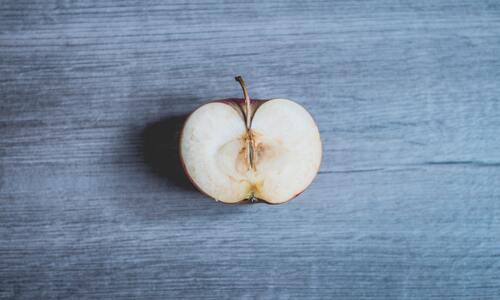Cutting an apple open only to find that it has what looks like white mold running through its core is certainly a frustrating experience, it’s even worse if you find the moldy core after you’ve finished eating it.
So, what is this white stuff in the middle of your apple core, why is it there in the first place, is it dangerous, and if not, can the apple still be eaten or should it be thrown out?
In this article, we will be answering all these questions and more in detail, so, to learn all you need to know about mold in apple cores, keep reading.
Mold in apple cores is characterized by a white or grey cotton-like substance usually located around the seeds of the fruit as a result of a fungal infection. The flesh of the fruit is not usually affected, however, over time it can develop into core rot, which will deteriorate the apple from within.

What causes mold in apple cores?
The main cause of mold in apple cores is caused by a fungus called mycelium, which enters the apple through the calyx (a small cavity at the bottom of the apple). This mold was present on the apple tree during the point at which the tree blossoms. As the tree is in bloom, the fungus moves into the apples as they develop and settles in the core.
The most common causes of mycelium mold developing within apples are particularly wet conditions during the point the apple tree flowers or consistent rainfall towards the end of summer. These high humidity circumstances are favorable for mold growth, and so mycelium spores may find their way onto the apple tree flowers and move into the fruits from there.
As a consumer, there is nothing you can do to prevent mold growth in the core of your apples, as this process has begun long before you purchased them.
What are the symptoms of moldy apple cores?
After cutting into an apple core, the main symptoms you will see are small white to sometimes thick, brown cotton-like growths usually present around the seeds of the apple.
It is highly unlikely that you would be able to see mold growth within an apple externally, however during ripening, the apple may fall prematurely from the tree.
Be aware though, not all white powdery substances within an apple core are actually mold. What can look like white mold can be perfectly natural growth around the seeds that appears with a white cotton-like texture, known as tufts.
Is the mold dangerous?
There are three commonly found strains of mold that have the potential to grow within the core of apples, these are Penicillium, Alternaria, and Botrytis.
Both Penicillium and Alternaira strains have the ability to produce toxins known as mycotoxins which can be hazardous to humans and animals, however, there have been no reports of mycotoxins being produced by Botrytis strains.
The most common health complaints reported from mycotoxin exposure are:
- Headaches
- Nausea
- Vomiting
- Breathlessness
- Fatigue
- Brain fog
- Skin irritation
Even though the amount of mold (or its spores), you would be exposed to would be very small (as the mold is concentrated within the core), it is still advised to avoid all contact with molds if possible, as some people can be severely allergic to them.
Can you eat apples with a moldy core?
The answer to this question depends entirely on how long the mold has infected the apple and much the infestation has progressed. For example, an apple that has mold within the core will not usually penetrate through into the flesh of the apple itself, therefore, should you finish the apple and not bite into the core, there would be little cause for concern.
However, it is possible for what may have started as a moldy core to turn into “core rot”, which is where the internalized mold begins to spread out into the flesh of the apple, causing it to begin to rot. In this case, once noticed, the apple should certainly not be eaten.
What types of apples are affected?
Apples that are more highly susceptible to having mold in their cores are the Red Delicious, Golden Delicious, and the Fuji. The reason for these particular apples being more susceptible to mold infestation than others is that they have a larger calyx than other varieties. The mold spores can then easily enter through the calyx and make their way to the core of the apple, where they begin to develop.
What is the black stuff in apple cores?
If upon cutting open an apple you notice patches of brown or black in and around the core, you could be dealing with black rot, a condition caused by the fungus Botryosphaeria obtusa.
Despite the apple looking less appetizing, any unaffected flesh is still fine to eat. Remember, the Botrytis strains are unlikely to produce mycotoxins, however, the flavor and coloration of the apple itself may be somewhat affected by the fungus.
It is sometimes possible to tell if an apple has been infected with Botryosphaeria obtusa, by looking at the area directly opposite to where the stem was. You may be able to see dark brown or black patches if the fungus has been growing for long enough.
Conclusion
Mold in apple cores is not usually something to be overly concerned with. It is often difficult to spot externally and is seen more clearly once the core is cut open. In some circumstances, some strains of mold that grow within an apple may cause allergic reactions in humans and pets.

